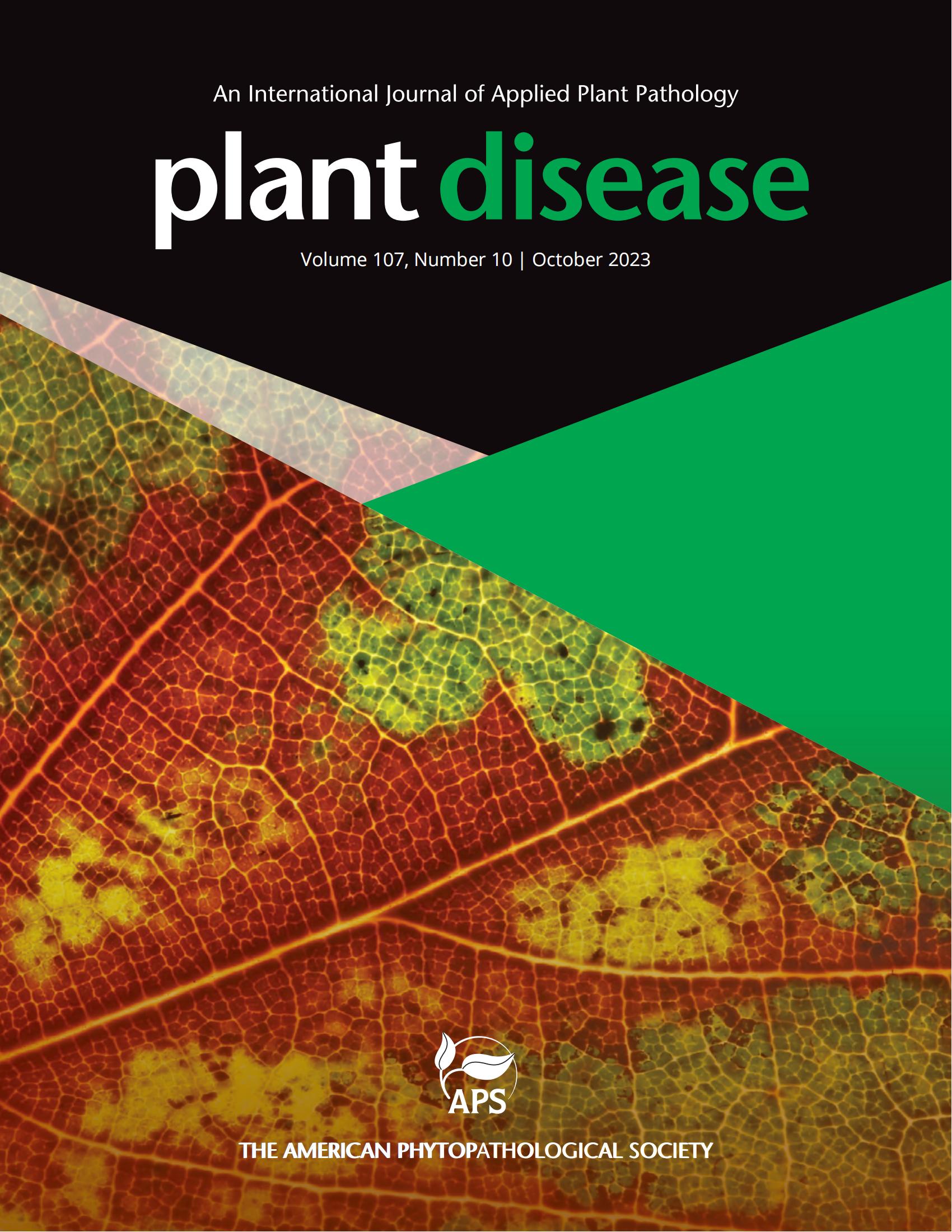首次报告美国佐治亚州由 Claviceps clavispora 引起的开关草(Panicum virgatum L.)麦角病。
摘要
开关草(Panicum virgatum L.)是一种具有生物燃料潜力的北美草种。据了解,Claviceps spp.可感染多种禾本科植物的小花,最初表现为黏稠的蜜露渗出物,后来以硬壳菌取代受感染子房中的种子(Tanaka et al,2023 年)。自 2019 年以来,从 7 月到 10 月,在佐治亚州观察到开关草圆锥花序上有蜜露和黑色硬壳菌。在佐治亚大学沃特金斯维尔铁马农场和提夫顿吉布斯农场的全基因组关联研究(GWAS)小组的 285 个入组品种中,部分品种首次发现了这种疾病。在佐治亚州沃特金斯维尔,2019 年、2020 年、2021 年和 2022 年的麦角发病率分别为 5%、6%、65% 和 54%。2021 年(样本 Scl)和 2023 年(样本 Cla_M 和 ATH20cl)从佐治亚州沃特金斯维尔收集到了带有蜜露和硬菌的症状圆锥花序。在显微镜下,出现蜜露症状的圆锥花序上有菌丝和分生孢子(长 9 μm [范围为 5-13 μm],宽 4 μm [3-5 μm]),与 Claviceps 菌属相符(Tooley 等人,2001 年)。菌丝长 1.5 毫米(1-3 毫米不等)。用 5%的 NaOCl 对硬菌表面消毒 3 分钟,然后用 70%的乙醇消毒,再用蒸馏水冲洗三次。将灭菌后的硬菌培养在马铃薯葡萄糖琼脂上,放在室温(22°C)下昼夜循环 12 小时的工作台上(Singh,1976 年)。2 个月后,硬菌产生无菌的顶端孢子。为了进行分子鉴定,按照 Doyle 和 Doyle(1987 年)的方法从三个蜜露样本中提取了基因组 DNA。使用 ITS4/ITS5(White 等,1990 年)和 5F2/7CR (Liu 等,1999 年)引物组扩增了内部转录间隔区(ITS)和 RNA 聚合酶第二大亚基(RPB2)基因。ATH20cl、Cla_M 和 Scl(GenBank 编号:PP546317- PP546319)的 ITS 区与 C. clavispora(NR_163506.1)的同一性为 92.83-97.48%。ATH20cl、Cla_M 和 Scl(GenBank 编号:PP573916- PP573918)的 RPB2 区与 C. clavispora(LT216566.1)的同一性为 97.46-97.72%。利用本研究的 ITS(539 bp)和 RPB2(792 bp)基因序列以及 Tanaka 等人(2023 年)的 11 条参考序列在 MEGA-X (Kumar 等人,2018 年)中构建的最大似然树显示,ATH20cl、Cla_M 和 Scl 与 Pusillae 节下的 C. clavispora 亲缘关系密切。样品 ATH20cl 和 Cla_M 的致病性试验是在温室中对种植在含有 Sungro 专业种植混合物的注塑花盆中的开关草栽培品种 "Alamo "进行的。通过将圆锥花序浸泡在 105 个孢子/毫升的悬浮液中 5 分钟并装袋 3 天,对处于生殖(R3)生长阶段的三株重复植株进行接种(Tooley 等人,2001 年)。对照植株浸泡在蒸馏水中。接种后 7 天和 90 天内分别出现蜜露症状和硬壳菌,而对照植株仍无症状。从受感染的阿拉莫圆锥花序上采集的蜜露经再次确认,产生的孢子与从田间采集的孢子相似。这是首次报告 C. clavispora 在开关草中引起的麦角病。自 2019 年以来,在田纳西州诺克斯维尔田纳西大学植物科学农场(University of Tennessee Plant Sciences Farm in Knoxville, TN)种植的同一 GWAS 小组的一些入选品种上也观察到了麦角菌。这些信息将有助于确定麦角菌对美国东南部开关草生物量生产和种子质量的影响。Switchgrass (Panicum virgatum L.) is a North American grass species with biofuel potential. Claviceps spp. is known to infect the florets of various grass species, initially characterized by a sticky honeydew exudate and later as sclerotium replacing the seed in the infected ovary (Tanaka et al 2023). Since 2019, from July to October, switchgrass panicles in Georgia have been observed with honeydew and black sclerotia. The disease was first noted on some of the 285 accessions of the genome-wide association study (GWAS) panels at the University of Georgia's Iron Horse Farm in Watkinsville and Gibbs Farm in Tifton, GA. In Watkinsville, GA, ergot incidence was 5%, 6%, 65% and 54% in 2019, 2020, 2021 and 2022, respectively. Symptomatic panicles with honeydew and sclerotia were collected in 2021 (sample Scl) and 2023 (samples Cla_M and ATH20cl) from Watkinsville, GA. Under microcopy, panicles with honeydew symptoms had mycelium and conidia (9 μm long [range of 5-13 μm] and 4 μm wide [3-5 μm]) consistent with Claviceps spp. (Tooley et al. 2001). Sclerotia were 1.5 mm long (range 1-3 mm). Sclerotia were surface sterilized for 3 minutes in 5% NaOCl, followed by 70% ethanol then rinsed three times in distilled water. Sterilized sclerotia were plated on potato dextrose agar and placed on bench top with a 12-hour day/night cycle at room temperature (22°C) (Singh 1976). After 2 months, the sclerotia produced sterile apothecia. For molecular identification, genomic DNA was extracted from three honeydew samples following the protocol of Doyle and Doyle (1987). The internal transcribed spacer (ITS) region and RNA polymerase second largest subunit (RPB2) gene were amplified using ITS4/ITS5 (White et al. 1990) and 5F2/7CR (Liu et al. 1999) primer sets. The ITS region of ATH20cl, Cla_M, and Scl (GenBank nos. PP546317- PP546319) showed 92.83-97.48% identity to C. clavispora (NR_163506.1). The RPB2 region of ATH20cl, Cla_M, and Scl (GenBank nos. PP573916- PP573918) showed 97.46-97.72% identity to C. clavispora (LT216566.1). The maximum likelihood tree constructed in MEGA-X (Kumar et al. 2018) using concatenated ITS (539 bp) and RPB2 (792 bp) gene sequences from this study and eleven reference sequences from Tanaka et al. (2023), revealed close relatedness of ATH20cl, Cla_M, and Scl to C. clavispora under section Pusillae. The pathogenicity test for samples ATH20cl and Cla_M was conducted in the greenhouse on switchgrass cultivar 'Alamo' grown in injection molded pots containing Sungro professional growing mix. Three replicates plants at reproductive (R3) growth stage were inoculated by immersing panicles in 105 spores/ml suspension for 5 minutes and bagged for 3 days (Tooley et al. 2001). Control plants were immersed in distilled water. Honeydew symptoms and sclerotia appeared within 7- and 90-days post-inoculation, respectively, whereas control plants remained symptom-free. The honeydew collected from the infected Alamo panicles were reconfirmed to produce similar spores to those collected from the field. This is the first report of ergot caused by C. clavispora in switchgrass. Ergot was also observed since 2019 on some accessions from the same GWAS panel planted at the University of Tennessee Plant Sciences Farm in Knoxville, TN. This information will be beneficial to determine the effect of ergot on biomass production and seed quality of switchgrass in the southeastern U.S.

 求助内容:
求助内容: 应助结果提醒方式:
应助结果提醒方式:


